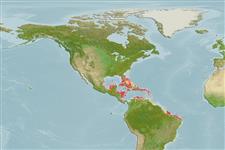>
Blenniiformes (Blennies) >
Labrisomidae (Labrisomids)
Etymology: Paraclinus: Greek, para = the side of + Greek, klinein, kline = sloping and bed, due to the four apophyses of sphenoid bone (Ref. 45335).
More on author: Steindachner.
Environment: milieu / climate zone / depth range / distribution range
Ecologie
marien rifbewoner; diepte 0 - 6 m (Ref. 9710). Tropical
Western Central Atlantic: southern Florida, USA and the Bahamas to Central America and northern South America; absent in the Antilles, except for Cuba.
Grootte / Gewicht / Leeftijd
Maturity: Lm ? range ? - ? cm
Max length : 10.0 cm TL mannelijk / geslacht onbekend; (Ref. 7251)
Dorsale stekels (totaal) : 28 - 29; Dorsale zachte stralen (totaal) : 1; Anale stekels: 2; Anale zachte stralen: 19 - 20.
Inhabits seagrass beds and coral reefs. May be found associated with the sponge Verongia fistularis (Ref. 13628). Sexual dimorphism in the shape of the head and dorsal fin (Ref. 5521). Oviparous (Ref. 205). Polygynous males guard the eggs which are spawned by several females in nests (Ref. 55842).
Levenscyclus en paargedrag
Maturities | Voortplanting | Spawnings | Egg(s) | Fecundities | Larven
Females deposit eggs in nests often associated with the sponge Verongia fistularis (Ref. 55842). Males fan the eggs for aeration which are probably spawned by several females owing to different developmental stages of eggs present in the nests (Ref. 205). Pairs will spawn routinely in aquaria in the absence of the sponges (Ref. 205).
According to aquarium observations by Breder (1941), "spawning takes place with the female in an inverted position while the male remains upright, wandering females adding to the eggs. The nesting male on sexual exhaustion repulses additional females with a typical warning attitude and eventual biting similar to its reaction to another male or other fish."
Robins, C.R. and G.C. Ray, 1986. A field guide to Atlantic coast fishes of North America. Houghton Mifflin Company, Boston, U.S.A. 354 p. (Ref. 7251)
Status op de Rode Lijst van het IUCN (Ref. 130435)
Gevaar voor de mens
Harmless
Gebruik door de mens
Visserij: commercieel; Aquarium: Commercieel
Tools
Speciale rapporten
Download XML
Internetbronnen
Estimates based on models
Preferred temperature (Ref.
123201): 23.8 - 28.2, mean 27.3 °C (based on 640 cells).
Fylogenetische diversiteitsindex (Ref.
82804): PD
50 = 0.5000 [Uniqueness, from 0.5 = low to 2.0 = high].
Bayesian length-weight: a=0.00912 (0.00399 - 0.02083), b=3.06 (2.87 - 3.25), in cm total length, based on LWR estimates for this (Sub)family-body shape (Ref.
93245).
Trofisch niveau (Ref.
69278): 3.7 ±0.4 se; based on size and trophs of closest relatives
Fishing Vulnerability (Ref.
59153): Low vulnerability (10 of 100).
Nutrients (Ref.
124155): Calcium = 117 [65, 212] mg/100g; Iron = 0.788 [0.459, 1.317] mg/100g; Protein = 18.9 [17.8, 19.9] %; Omega3 = 0.137 [0.080, 0.231] g/100g; Selenium = 16.5 [8.1, 32.6] μg/100g; VitaminA = 177 [58, 550] μg/100g; Zinc = 2.07 [1.39, 2.93] mg/100g (wet weight);
